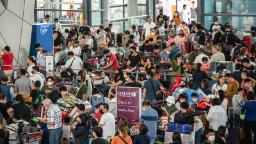[ad_1]

Ninoy Aquino International Airport (MNL) is the main gateway for travelers to the Philippines, serving the capital Manila and surrounding region.
Technical issues were first detected on Sunday morning, the airport operator, Civil Aviation Authority of the Philippines (CAAP), said in a statement.
A total of 282 flights were either delayed, canceled or diverted to other regional airports while around 56,000 passengers were affected as of 4 p.m. local time on New Year’s Day, it added. It was unclear how many overflights were affected, reported Reuters.
In a press conference held on the evening of Sunday, January 1, Philippine Transportation Secretary Jaime Bautista apologized for the inconvenience caused to passengers and said that the airport’s central air traffic control system had suffered from a severe power outage. Although there was a back-up power supply, it had failed to supply enough power, he added.
“This was an air traffic management system issue,” Bautista said. “If you will compare (our airport) with Singapore’s, for one, there is a big difference — they are at least 10 years ahead of us,” he said.
Bautista added that his transportation department had also coordinated with the affected airlines to provide food, refreshments, transportation and accommodation “free of charge to all affected passengers.”
Among the flights affected by the airspace outage was a Manila-bound Qantas plane that departed from Sydney shortly before 1 p.m. local time on January 1. Three hours into its eight-hour journey, Flight QF19 was then forced to turn around mid-flight and return to Australia.
“All airlines were prevented from arriving into Manila on Sunday afternoon as local authorities closed the local airspace,” Qantas said in a statement. “This meant our flight from Sydney had to turn around.”
Operations had partially resumed as at 5:50 p.m. local time, CAAP said in an update, and that the airport had once again begun to accept inbound flights. A statement from the Department of Transport shared on Facebook said that airport operations were back to normal while equipment restoration was still ongoing.
Global air travel was hard hit by the Covid-19 pandemic but passenger traffic has been slowly recovering, with industry experts predicting the industry to return to previous normal levels by 2025.
Photos and videos shared online showed massive crowds at NAIA. Snaking queues were seen at several check-in counters. Many passengers lugging around their luggage were also spotted huddling around flight arrival screens waiting for updates.
“Six hours of useless flying,” he said. “Inconvenience to travelers and losses to tourism and business are horrendous.” His plane eventually landed in Manila at 11 p.m. local time, Pangilinan said.
Student Xavier Fernandez was one of thousands affected by the New Year flight disruptions. He spent hours on the phone with United Airlines and other flight companies to rebook his flight to San Francisco at a later date. “It’s been an absolute nightmare,” he told CNN, adding that he had been in the airport for more than 10 hours.
Fernandez also said there had been other passengers who had boarded their aircraft on Sunday morning before the power outages were announced, and ultimately had to disembark their planes after waiting for several hours on board.
The large scale flight disruptions come amid a busy annual year end travel period in the Philippines, which sees large numbers of foreign tourists as well as overseas citizens flying into the country from abroad to mark Christmas and New Year, some of the country’s most important holiday celebrations.
Fernandez had been in Manila to celebrate Christmas and the New Year with his family.
“Literally the worst way to start the year,” he said of the episode.
[ad_2]
Source link



